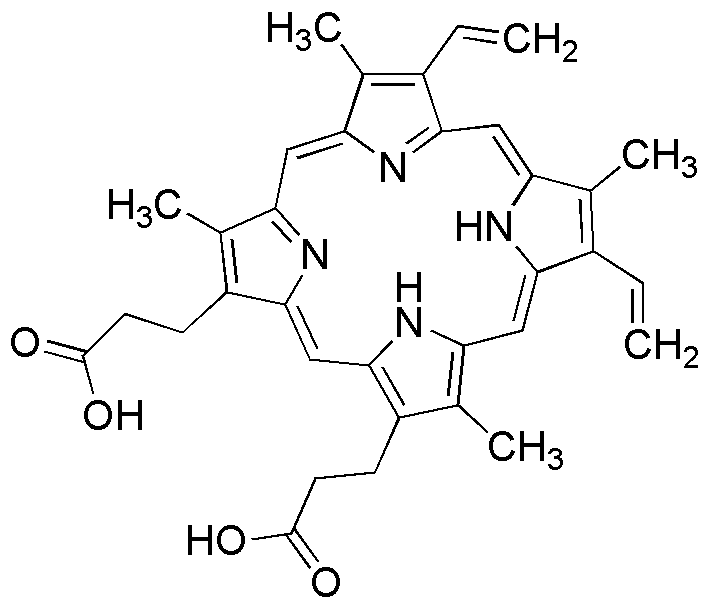Protoporphyrin IX is widely utilized in research focused on:
- Medical Diagnostics: It plays a crucial role in photodynamic therapy (PDT) for treating certain cancers. By absorbing light, it generates reactive oxygen species that can selectively destroy cancer cells, making it a valuable tool in oncology.
- Biochemical Research: This compound is essential in studying heme biosynthesis and its related disorders. Researchers use it to understand the mechanisms of diseases like porphyria, providing insights into metabolic pathways.
- Drug Development: Protoporphyrin IX is used as a photosensitizer in drug formulations. Its ability to target specific tissues enhances the efficacy of treatments while minimizing side effects, which is particularly beneficial in targeted therapies.
- Environmental Monitoring: It serves as a biomarker for assessing the health of aquatic ecosystems. By measuring its levels in organisms, scientists can gauge the impact of pollutants and environmental changes.
- Cosmetic Applications: Due to its antioxidant properties, it is being explored in skincare formulations. It can help protect skin cells from oxidative stress, contributing to anti-aging products.
General Information
Properties
Safety and Regulations
Applications
Protoporphyrin IX is widely utilized in research focused on:
- Medical Diagnostics: It plays a crucial role in photodynamic therapy (PDT) for treating certain cancers. By absorbing light, it generates reactive oxygen species that can selectively destroy cancer cells, making it a valuable tool in oncology.
- Biochemical Research: This compound is essential in studying heme biosynthesis and its related disorders. Researchers use it to understand the mechanisms of diseases like porphyria, providing insights into metabolic pathways.
- Drug Development: Protoporphyrin IX is used as a photosensitizer in drug formulations. Its ability to target specific tissues enhances the efficacy of treatments while minimizing side effects, which is particularly beneficial in targeted therapies.
- Environmental Monitoring: It serves as a biomarker for assessing the health of aquatic ecosystems. By measuring its levels in organisms, scientists can gauge the impact of pollutants and environmental changes.
- Cosmetic Applications: Due to its antioxidant properties, it is being explored in skincare formulations. It can help protect skin cells from oxidative stress, contributing to anti-aging products.
Documents
Safety Data Sheets (SDS)
The SDS provides comprehensive safety information on handling, storage, and disposal of the product.
Product Specification (PS)
The PS provides a comprehensive breakdown of the product’s properties, including chemical composition, physical state, purity, and storage requirements. It also details acceptable quality ranges and the product's intended applications.
Certificates of Analysis (COA)
Search for Certificates of Analysis (COA) by entering the products Lot Number. Lot and Batch Numbers can be found on a product’s label following the words ‘Lot’ or ‘Batch’.
*Catalog Number
*Lot Number
Certificates Of Origin (COO)
This COO confirms the country where the product was manufactured, and also details the materials and components used in it and whether it is derived from natural, synthetic, or other specific sources. This certificate may be required for customs, trade, and regulatory compliance.
*Catalog Number
*Lot Number
Safety Data Sheets (SDS)
The SDS provides comprehensive safety information on handling, storage, and disposal of the product.
DownloadProduct Specification (PS)
The PS provides a comprehensive breakdown of the product’s properties, including chemical composition, physical state, purity, and storage requirements. It also details acceptable quality ranges and the product's intended applications.
DownloadCertificates of Analysis (COA)
Search for Certificates of Analysis (COA) by entering the products Lot Number. Lot and Batch Numbers can be found on a product’s label following the words ‘Lot’ or ‘Batch’.
*Catalog Number
*Lot Number
Certificates Of Origin (COO)
This COO confirms the country where the product was manufactured, and also details the materials and components used in it and whether it is derived from natural, synthetic, or other specific sources. This certificate may be required for customs, trade, and regulatory compliance.


